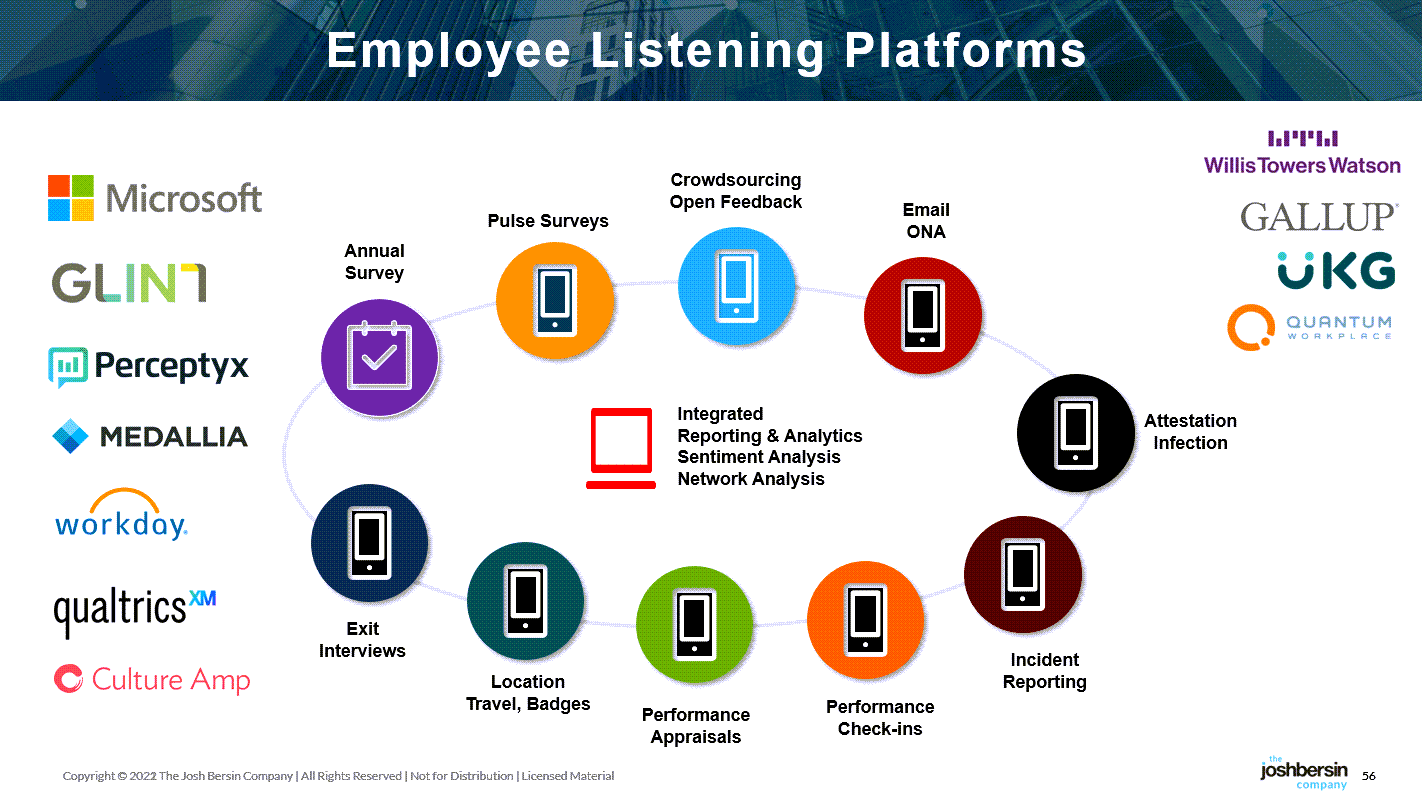Microsoft Brings Glint Into Viva: A Shoe Drops In The Employee Experience Market
This week Microsoft made a significant move: moving Glint from LinkedIn into Microsoft Viva, building what Microsoft calls “Employee Feedback In The Flow Of Work.”
Glint is one of the leading providers of employee listening and action platforms, competing with the likes of Medallia, Qualtrics, Peakon (owned by Workday), CultureAmp, and Perceptyx. These companies sell integrated survey, analytics, and employee listening platforms and store massive amounts of employee data used to figure out what’s really going on inside of companies.
As I’ve written about for many years, the employee listening market has grown up fast. Once considered a cottage industry of industrial psychologists and survey tools (Gallup, Towers, and dozens of others build these things), this market is now one of the hottest spaces in HR Tech. Why? Because every single company is trying to figure out how to better retain, attract, develop, and engage its workers.
And the market has expanded. Not only do these systems give executives a view of the “Voice of the Employee,” they also serve as “action platforms” as well. If you are unhappy with your manager or the floor operations in your retail store, you can now provide feedback and suggestions that go directly to line leadership. And leaders can get developmental tips, action plans, and nudges to help them improve behavior or specific programs.
For many years I saw this as a closed-loop system, one that should be as important as customer analytics in business. After all, employees are not just “workers to keep satisfied.” They are, in effect, the best “voice of the customer you have.” So if you know how your employees are doing, you know how your company is performing.
And employees have a lot to add: if you survey and listen to them well, they will give you suggestions, feedback, and important ideas that make your company better. Witness the old-fashioned “suggestion box” that I saw at IBM in the 1980s. Those anonymous “suggestions” often turned into billion-dollar ideas. You want this kind of free-flowing feedback to be welcome and reach managers in the most direct way possible.
The Massive Impact Of Microsoft Viva
Microsoft Viva is a suite of tools (Viva Learning, Insights, Connections, Topics, and Ally.io) that any company can buy to handle all the messy, difficult things we do for employees. This suite, which took the market by storm when it was launched in 2021, is now sweeping across IT and HR departments and starting to change the HR market in big ways. If you use Microsoft Office, Teams, or Azure its easy to license Viva, so you just have to “turn it on.” And when you do, all your employee communications become more exciting.
This month is the one-year anniversary of Viva availability and Microsoft already has 10 million paid users, 1,000 customers, and more than 300 enterprise-class integrated applications.
I won’t get into the whole Viva story (you can read about it here), but suffice it to say that Glint, which is one of the more advanced survey and listening platforms in the market, is going to fit into Viva perfectly. (Microsoft also announced that they will do all their internal employee listening on Glint.)
 |
Here are some of the implications.
First, companies that want an end-to-end employee listening system don’t necessarily need a new vendor anymore. If they are a Microsoft shop they can get an enterprise survey and analytics platform that employees will use immediately.
Second, companies that use Viva today will be able to match Viva Insights data (how much time are you spending in meetings, how productive you are) against direct employee feedback, engagement, and suggestion data. The data scientists that analyze Glint data will be sitting next to the data scientists that access Viva Insights data. They’ll start to see what behaviors, meetings, and other activities drive employee retention, improve diversity, and contribute to wellbeing.
Third, this vastly improves Microsoft Viva’s learning capabilities. Glint is not only a survey and listening system, it also delivers action plans and developmental recommendations. Within a year or so I bet this is all integrated into Viva Learning, making it easier than ever to “learn what you need to know” when employees are unhappy. The possibilities are endless.
Finally, this means that Microsoft now has a deeply skilled team of I/O Psychologists, organizational consultants, and data scientists focused on employees – all in one place. The Viva team, which was probably populated by lots of Microsoft software specialists, now has a deep pool of HR, organization, and assessment experts.
Other Vendors Are Not Standing Still
This market is so hot that every vendor is investing. Perceptyx just acquired Waggl, CultureIQ, and Cultivate. Qualtrics just launched its EX25 model and told me that almost 40% of all their revenue is now coming from EX applications. Peakon is one of the fastest-growing revenue products at Workday. ServiceNow announced Listening Posts integrated into its platform. And Medallia is doubling down on its EX product line as well.
When I talk with these vendors I frequently hear growth rates like 40-60% year over year growth. And this makes sense. Every company in the world needs an employee listening platform, and the older survey tools have just not been able to keep up. Today companies want a system that handles many forms of feedback, crowdsourcing, natural language processing, as well as 360 feedback, real-time analytics, manager dashboards, and alerts and workflow management.
This is why Microsoft’s decision is a good one. One of the biggest challenges in business (and HR) is getting steady, useful feedback from employees. Glint, integrated into Viva, is going to make this easier than ever. Vendors like Qualtrics, Medallia, Perceptyx, Peakon, and Cultureamp are going to have to beef up their Microsoft integration plans. And Microsoft will continue to be an open platform and support all ecosystem partners.
Congrats to Microsoft for continuing to push the EX strategy. Let’s hope these development teams do some amazing work together – the upside could be enormous.
Additional Information
Glint and LinkedIn Learning Get Married


